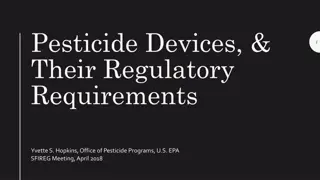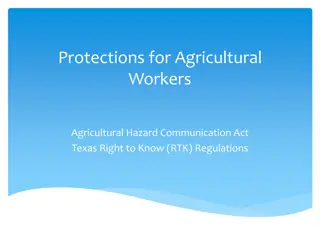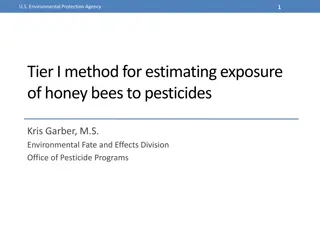Important Updates in Pesticide Regulations and Program Changes
New pesticide regulations and program changes are introduced, including requirements for obtaining a pesticide applicator license, major proposed changes to the Worker Protection Standard (WPS) by the EPA, introduction of new inspectors, and the phaseout of Endosulfan. Special Maine registrations for controlling spotted wing drosophila are also highlighted.
Download Presentation

Please find below an Image/Link to download the presentation.
The content on the website is provided AS IS for your information and personal use only. It may not be sold, licensed, or shared on other websites without obtaining consent from the author.If you encounter any issues during the download, it is possible that the publisher has removed the file from their server.
You are allowed to download the files provided on this website for personal or commercial use, subject to the condition that they are used lawfully. All files are the property of their respective owners.
The content on the website is provided AS IS for your information and personal use only. It may not be sold, licensed, or shared on other websites without obtaining consent from the author.
E N D
Presentation Transcript
2014 BPC Update 287-2731 www.thinkfirstspraylast.org
Private Applicator of General Use Pesticides Agricultural Basic License Public Law 2011, Chapter 169 requires anyone producing and selling over $1,000 worth of agricultural plants or plant products/year for human consumption to obtain a pesticide applicator license by April 1, 2015 Growers must obtain an Agricultural Basic, or Private Pesticide Applicator license
Introducing two new inspectors Heidi Nelson Downeast Formerly worked at USDA- FSA & NRCS Megan Patterson Mid Coast Formerly worked for DuPont and Green Thumb Farms
EPA proposes changes to the WPS EPA has issued a NPRM Published in the Federal Register on March 19 Handout gives information on major proposals and where to comment Comments due by June 17, 2014 http://www.epa.gov/oppfead1/safety/workers/proposed/index.htm l
Major proposed WPS changes include Annual training of workers and handlers Was every 5 years Mandatory posting for high toxicity pesticides Minimum age of 16 for pesticide handlers 25 100 foot restricted entry zones around all treatment areas
Major proposed WPS changes include Records of training and any early entry Respirator fit testing and medical evaluation (OSHA standard) Remove requirement for central information displays
Endosulfan (Thiodan) phaseout Group E: Use ends July 31, 2015 Apple Blueberry Peppers Potatoes Pumpkins Sweet corn Tomato Winter squash No endorsement intended or implied
Special Maine registrations for SWD EPA SLN NO. ME-130001, Gowan Company, Gowan Malathion 8 Flowable, EPA Reg. No. 10163-21, for use on blueberries to control spotted wing drosophila EPA SLN NO. ME-130002, Gowan Company, Gowan Malathion 8 Flowable, EPA Reg. No. 10163-21, for use on caneberries to control spotted wing drosophila EPA SLN NO. ME-130003, Loveland Products, Inc., Malathion 8 Aquamul, EPA Reg. No. 34704-474, for use on blueberries to control spotted wing drosophila Hannah Burrack, North Carolina State University, Bugwood.org
Changes to the Hazard Communication Standard The Federal Hazard Communication Standard (called worker right to know ) has been harmonized with international standards MSDSs are now SDSs Signal words have changed Employers must retrain employees on the changes
Label signal word and SDS warnings may not match
Employee Information and Training HAZCOM 1994 HAZCOM 2012 Requires employee information and training before a worker is exposed to the hazardous chemicals in the workplace, and whenever the hazard changes. Clarifies that the labels on shipped containers and workplace labels must be explained, as well as the SDS format. Workers will have to be trained on the new label and SDS formats before all the provisions of the rule are effective. Pesticide labels will not change due to GHS HazCom 2012 says: Employers shall train employees regarding the new label elements and safety data sheet format by December 1, 2013.
Good Reading The Pesticide Label The BPC Inspectors are noticing growers making some mistakes Fungicide labels may not be specific, but restrictions on the number of applications apply even when you use two different product formulations No endorsement intended or implied
Must read the label carefully Bravo labels Weatherstik and Ultrex No endorsement intended or implied
Must read the label carefully Pay attention to labels for restrictions on total active ingredient per acre per year No endorsement intended or implied
Must read the label carefully Tank mixes may be prohibited No endorsement intended or implied
Pollinator Protection Bee kills are in the news! Legislators are asking for bans or moratoriums all over the country Portland, Oregon Growers must be extremely careful This case involved Safari which is dinotefuran that was applied to control aphids just some linden trees had started to bloom The applicator was fined $1,665.00 for not following the label
New use directions Ag products & Non-Ag products 2. Cont.
Measuring low rate pesticides Inspectors have seen growers that are not measuring dry pesticide products properly Our English system of measurements can be very confusing since we have both dry and liquid ounces Products like Resolve DF prescribe applications rates in ounces per acre How do you make sure to get the right rate? No endorsement intended or implied
First Conclusion More precision required when measuring products by the ounce No endorsement intended or implied
800 Gallon Tank 10 gallons per acre, now many acres will tank do? 20 gallons per acre, how many acres will tank do? 15 gallons per acre, how many acres will tank do?
800 Gallon Tank 10 gallons per acre, now many acres will tank do? 80 20 gallons per acre, how many acres will tank do? 40 15 gallons per acre, how many acres will tank do? 53
Many new pesticides are very low rate products With low rate products measuring properly is even more important Even slight miscalculations can result in crop damage Ontario Ministry of Ag "flash" of yellow on the leaf and crinkling
Second Conclusion Make sure device is accurate
Must have a good scale or a product specific calibrated measuring cup Dry ounces can only be accurately measured using a good quality scale (postal scales work well) Calibrated measuring devices are fine but must be specifically designed for the product used No endorsement intended or implied
Fourth Conclusion Use the measuring device that comes with dry materials No endorsement intended or implied
DRY OUNCE DRY OUNCE No endorsement intended or implied
What are the consequences of using the wrong measuring tube?
Fifth Conclusion Devices not very accurate. Weighing out material will get you the most accurate measurement. No endorsement intended or implied
Sixth Conclusion Throw away the measuring device after your supply has run out. No endorsement intended or implied
Seventh Conclusion TANK AGITATION Keep the dry product agitated in the spray tank You might have to premix if water is really cold
VERIFY TANK MEASUREMENTS Must verify tank measurements with a flow meter!
Summary Summary More More precision precision needed for ounce needed for ounce measurements measurements Accurate Measurement Starts the Chain of Events to Success or Failure Dry Dry and liquid and liquid ounces are ounces are different different Use Use specific tubes specific tubes made for made for dry products products dry Weigh Weigh dry products for products for accuracy accuracy dry
Throw Throw away dry measuring dry measuring tubes tubes away Summary Summary A Little Inaccuracy, A Little Inaccuracy, Perhaps a Ton of Perhaps a Ton of Explanation Explanation Ask Ask retailer for retailer for dry tube that dry tube that came with came with product product Keep Keep dry products well products well agitated agitated dry Make Make sure spray tank is spray tank is accurately accurately marked marked sure Nicosulfuron damage on corn
Acknowledgements Thanks to Fred Whitford Purdue University and Pat Hipkins Virginia Cooperative Extension for the slides on measuring small amounts of pesticides
2014 Pesticide Bills in Maine Legislature Three pesticide bills have made it through the Legislative Council 1. A 2-year moratorium on neonicotinoids 2. Prohibition on methoprene and resmethrin if they will enter the Gulf of Maine 3. Approval of more pesticides for Medical Marijuana producers
LD 1587 An Act to Temporarily Ban the Use of Neonicotinoid Pesticides Voted out of committee as Ought Not to Pass Feb 13, 2014
LD 1678 An Act to Protect Maines Lobster Fishery Voted out of committee as Ought Not to Pass Feb 13, 2014 New York Times
LD 1674 An Act to Further Ensure the Provision of Safe Medical Marijuana to Maine Patients Committee is currently divided on this bill. An amended bill is being worked on which will allow them to use any Maine registered product that is labeled for All Plants .
LD 1758 Repeal of the container deposit law and rules The Legislature and Board repealed the requirements for deposits on limited and restricted use pesticide containers The Legislature added a new clause that requires dealers to continue refunding outstanding deposits paid when growers return containers with Board issued stickers until 12/31/2017























